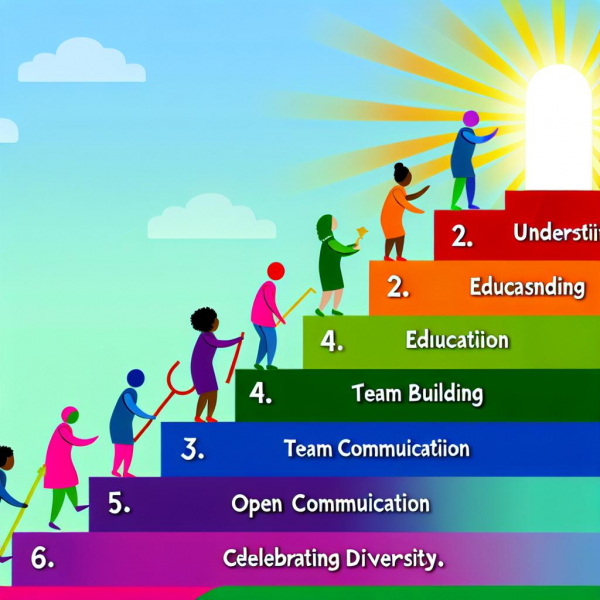In the grand tapestry of the corporate world, each thread represents a unique individual, each with their own set of skills, experiences, and perspectives. When woven together, these threads create a vibrant, resilient fabric that is far stronger than any single strand. This is the power of diversity. It is not just a buzzword or a box to be ticked on a corporate checklist, but a transformative force that can fortify your company from the inside out. This article will delve into the myriad ways promoting diversity can strengthen your company, turning it into a dynamic powerhouse of innovation, productivity, and success. So, let’s embark on this journey of exploration, where diversity is not just celebrated, but harnessed as a potent tool for corporate growth.
Table of Contents
- Understanding the Power of Diversity in the Workplace
- The Role of Leadership in Promoting Diversity
- Creating a Culture of Inclusion: Steps to Success
- Harnessing the Benefits of a Diverse Workforce
- Overcoming Challenges in Implementing Diversity Initiatives
- Strategies for Sustaining Diversity and Inclusion in Your Company
- Case Studies: Companies Excelling in Diversity and Inclusion
- Q&A
- Insights and Conclusions

Understanding the Power of Diversity in the Workplace
Embracing diversity in the workplace is more than just a noble and ethical decision. It’s a strategic move that can propel your company to new heights. A diverse workforce brings a variety of perspectives, ideas, and experiences to the table, which can lead to innovative solutions and improved decision making. Diversity can also enhance your company’s reputation, making it more attractive to a broader range of clients, customers, and potential employees.
Consider the following benefits of promoting diversity in your workplace:
- Increased Creativity: When employees with different backgrounds and experiences come together, they bring unique perspectives that can lead to innovative solutions.
- Improved Problem Solving: Diverse teams are more likely to examine problems from multiple angles and come up with a wider range of solutions.
- Enhanced Company Reputation: Companies that value diversity are often viewed more favorably by customers, clients, and potential employees.
Let’s take a look at some statistics that highlight the power of diversity:
| Statistic | Explanation |
|---|---|
| Companies with diverse management teams have 19% higher revenue | This is due to innovation resulting from diversity. |
| 67% of job seekers consider workplace diversity an important factor | Companies that promote diversity are more likely to attract top talent. |
| Diverse companies are 1.7 times more likely to be innovation leaders in their market | Diversity fosters creativity and innovation. |
As these statistics show, promoting diversity is not just the right thing to do; it’s good for business. By fostering a diverse and inclusive workplace, you can harness the power of diversity to strengthen your company.

The Role of Leadership in Promoting Diversity
Leadership plays a pivotal role in fostering a culture of diversity within an organization. It is the responsibility of the leaders to create an environment where everyone feels valued and respected, regardless of their race, religion, gender, age, or sexual orientation. This can be achieved by implementing diversity training programs, promoting open communication, and ensuring fair treatment of all employees. Leaders who embrace diversity not only promote a positive work environment but also drive innovation and creativity within their teams.
Here are some ways in which leadership can promote diversity:
- Setting clear expectations: Leaders should set clear expectations about the importance of diversity and inclusion. This can be done through company policies, team meetings, and one-on-one conversations.
- Leading by example: Leaders should demonstrate their commitment to diversity through their actions. This includes treating everyone with respect, promoting diverse individuals into leadership roles, and speaking out against discrimination.
- Providing training: Diversity training can help employees understand the benefits of diversity and learn how to interact with people from different backgrounds. Leaders should ensure that this training is provided to all employees.
- Encouraging diverse perspectives: Leaders should encourage employees to share their unique perspectives and ideas. This can lead to more innovative solutions and a more inclusive work environment.
| Leadership Role | Action |
|---|---|
| Setting clear expectations | Implementing company policies, conducting team meetings |
| Leading by example | Promoting diverse individuals, speaking out against discrimination |
| Providing training | Offering diversity training to all employees |
| Encouraging diverse perspectives | Inviting employees to share their unique ideas |
By promoting diversity, leaders can create a more inclusive and innovative work environment. This not only benefits the employees but also strengthens the company as a whole.

Creating a Culture of Inclusion: Steps to Success
Creating a culture of inclusion within your company is not just about ticking boxes or meeting quotas. It’s about fostering an environment where everyone, regardless of their background, feels valued and able to contribute their best. This not only benefits the individuals within your team but also strengthens your company as a whole. A diverse workforce brings a wider range of perspectives, ideas, and experiences, which can lead to more innovative solutions and better decision-making.
So, how can you create this culture of inclusion? Here are some steps to success:
- Commitment from the top: Leaders need to set the tone by demonstrating a commitment to diversity and inclusion. This can be through their words, actions, and policies.
- Training and education: Provide diversity and inclusion training for all employees. This can help to challenge biases and stereotypes, and promote understanding and respect.
- Open communication: Encourage open dialogue about diversity and inclusion. This can help to raise awareness, address concerns, and foster a sense of belonging.
- Recognition and respect: Recognize and respect the unique contributions of each individual. This can help to build self-esteem and promote a sense of belonging.
Here’s a simple table to illustrate the impact of these steps:
| Steps | Impact |
|---|---|
| Commitment from the top | Establishes a culture of inclusion |
| Training and education | Challenges biases and promotes understanding |
| Open communication | Raises awareness and fosters belonging |
| Recognition and respect | Builds self-esteem and promotes belonging |
Remember, creating a culture of inclusion is a journey, not a destination. It requires ongoing effort and commitment. But the rewards – a stronger, more diverse, and more innovative company – are well worth it.
Harnessing the Benefits of a Diverse Workforce
Embracing diversity in the workplace is more than just a noble and ethical decision. It’s a strategic move that can propel your company to new heights. A diverse workforce brings a wide array of perspectives, ideas, and experiences to the table, which can foster innovation, improve decision-making, and enhance problem-solving capabilities. Moreover, it can help your company appeal to a broader customer base and attract top talent from various backgrounds.
Here are some ways to harness the benefits of a diverse workforce:
- Encourage Inclusivity: Create an environment where everyone feels valued and included. This can be achieved by promoting open communication, providing equal opportunities, and implementing inclusive policies and practices.
- Provide Diversity Training: Equip your employees with the knowledge and skills to work effectively in a diverse environment. This can help reduce biases, improve interpersonal relationships, and foster a culture of respect and understanding.
- Implement Diverse Hiring Practices: Make a conscious effort to recruit from a diverse pool of candidates. This can help increase the diversity of your workforce and bring in fresh perspectives.
| Benefits | Methods |
|---|---|
| Increased Creativity | Encourage diverse perspectives and ideas |
| Improved Decision Making | Utilize diverse experiences and knowledge |
| Enhanced Problem Solving | Apply diverse approaches and solutions |
| Broader Customer Appeal | Understand and cater to diverse customer needs |
| Attracting Top Talent | Offer an inclusive and diverse work environment |
By promoting diversity, you can not only strengthen your company but also create a more inclusive and equitable society. So, start today!
Overcoming Challenges in Implementing Diversity Initiatives
Implementing diversity initiatives in a company can be a challenging task. It requires a deep understanding of the company’s culture, a commitment to change, and the ability to navigate resistance. However, the benefits of a diverse workforce are well-documented, including increased creativity, better decision-making, and improved performance. Therefore, it’s crucial to overcome these challenges and create a more inclusive workplace.
One of the main challenges is resistance to change. Employees may be comfortable with the status quo and resist efforts to diversify the workforce. To overcome this, it’s important to communicate the benefits of diversity clearly and consistently. This can be done through workshops, training sessions, and regular communication from leadership. It’s also important to create a safe space for employees to express their concerns and fears about the changes.
- Unconscious bias is another major challenge. Even when we think we’re being fair, our unconscious biases can influence our decisions. To combat this, companies can implement unconscious bias training and use objective criteria for hiring and promotion decisions.
- Lack of diversity in leadership can also be a barrier. If the leadership team is not diverse, it can be difficult for employees from underrepresented groups to feel included and valued. Companies can address this by actively recruiting and promoting diverse leaders.
- Finally, insufficient resources can hinder diversity initiatives. Implementing these initiatives requires time, money, and effort. Companies can overcome this by allocating sufficient resources to diversity efforts and making them a priority.
| Challenge | Solution |
|---|---|
| Resistance to change | Communicate benefits, create safe space for concerns |
| Unconscious bias | Implement unconscious bias training, use objective criteria |
| Lack of diversity in leadership | Recruit and promote diverse leaders |
| Insufficient resources | Allocate sufficient resources, prioritize diversity efforts |
Strategies for Sustaining Diversity and Inclusion in Your Company
Embracing diversity and inclusion in the workplace is more than just a noble and ethical decision. It’s a strategic move that can lead to significant benefits for your company, including increased creativity, improved problem-solving, and a better understanding of your customer base. However, maintaining this diversity and inclusion can be a challenge. Here are some strategies that can help.
1. Foster an inclusive culture: This starts with leadership. Leaders should model inclusive behavior and make it clear that diversity is valued. This can be done through regular communication, training, and by holding everyone accountable for their actions. In addition, it’s important to create a safe space where employees feel comfortable expressing their thoughts and ideas. This can be achieved by implementing policies that promote respect and equality, and by encouraging open dialogue.
2. Provide diversity and inclusion training: Training can help employees understand the importance of diversity and inclusion, and how they can contribute to it. It can also help them recognize and overcome unconscious biases that may be hindering diversity efforts. Training should be ongoing and should be tailored to the needs of your company.
3. Implement diverse hiring practices: This includes actively seeking out candidates from diverse backgrounds, and ensuring that your hiring process is free from bias. It also means considering diversity in all its forms, including race, gender, age, sexual orientation, and disability.
| Strategy | Description |
|---|---|
| Foster an inclusive culture | Create a safe space where employees feel comfortable expressing their thoughts and ideas. |
| Provide diversity and inclusion training | Help employees understand the importance of diversity and inclusion, and how they can contribute to it. |
| Implement diverse hiring practices | Actively seek out candidates from diverse backgrounds, and ensure that your hiring process is free from bias. |
Remember, diversity and inclusion is not a one-time initiative, but a long-term commitment. It requires continuous effort and attention, but the rewards are well worth it. By promoting diversity, you can create a more dynamic, innovative, and successful company.
Case Studies: Companies Excelling in Diversity and Inclusion
When it comes to promoting diversity and inclusion, some companies are leading the way and setting an example for others to follow. These companies understand that diversity is not just about ticking boxes, but about creating a culture where everyone feels valued and included. They also understand that diversity and inclusion can drive innovation, improve decision-making, and contribute to business success.
One such company is Google. The tech giant has made significant strides in promoting diversity and inclusion. They have implemented a number of initiatives, including unconscious bias training for employees, and have set ambitious goals for increasing the representation of underrepresented groups. Google also publishes an annual diversity report, demonstrating their commitment to transparency and accountability.
- Accenture is another company that excels in this area. They have a comprehensive diversity and inclusion strategy that includes a strong focus on gender equality. Accenture has set a goal to achieve a gender-balanced workforce by 2025, and they are well on their way to achieving this. They also have a number of programs in place to support employees from diverse backgrounds, including mentoring and leadership development programs.
- Finally, Johnson & Johnson deserves a mention. This healthcare company has a long history of promoting diversity and inclusion. They were one of the first companies to appoint a woman to their Board of Directors, back in 1944. Today, they continue to promote diversity and inclusion through a range of initiatives, including employee resource groups, diversity training, and a global diversity and inclusion strategy.
| Company | Diversity & Inclusion Initiatives |
| Unconscious bias training, diversity goals, annual diversity report | |
| Accenture | Gender equality focus, mentoring and leadership development programs |
| Johnson & Johnson | Employee resource groups, diversity training, global diversity and inclusion strategy |
These companies show that promoting diversity and inclusion is not just the right thing to do, but it’s also good for business. By creating a culture where everyone feels valued and included, companies can attract and retain the best talent, drive innovation, and achieve business success.
Q&A
Q: What is the significance of promoting diversity in a company?
A: Promoting diversity in a company is crucial as it brings together a mix of different perspectives, experiences, and skills. This can lead to more innovative ideas, better decision-making, and improved problem-solving abilities.
Q: How can diversity strengthen a company?
A: Diversity can strengthen a company in numerous ways. It can enhance creativity and innovation, improve employee engagement, and lead to better decision-making. It can also help a company to better understand and serve its diverse customer base.
Q: What are some practical ways to promote diversity in the workplace?
A: Some practical ways to promote diversity include implementing inclusive hiring practices, providing diversity and inclusion training, creating a safe space for open dialogue about diversity-related issues, and promoting diverse leadership within the company.
Q: How does diversity impact a company’s reputation?
A: A company that values and promotes diversity is often seen as more socially responsible and progressive. This can enhance its reputation among customers, potential employees, and other stakeholders, potentially leading to increased business and talent attraction.
Q: Can promoting diversity have any negative impacts on a company?
A: While promoting diversity has many benefits, it can also present challenges. For example, it may lead to conflicts or misunderstandings due to cultural differences. However, these challenges can be overcome with effective communication, training, and leadership.
Q: How can a company measure the success of its diversity initiatives?
A: Success can be measured in various ways, such as through employee surveys, diversity metrics (like the percentage of diverse hires or promotions), and feedback from employees and customers. The impact on business outcomes, such as innovation, customer satisfaction, and financial performance, can also be assessed.
Q: What role does leadership play in promoting diversity?
A: Leadership plays a crucial role in promoting diversity. Leaders set the tone for the company’s culture and values, and their commitment to diversity can inspire others to follow suit. They can also implement policies and practices that promote diversity and inclusion.
Q: What is the difference between diversity and inclusion?
A: While diversity refers to the presence of different types of people (e.g., in terms of race, gender, age, etc.), inclusion refers to the extent to which these diverse individuals are valued, respected, and integrated into all aspects of the company. Both are important for creating a truly inclusive and equitable workplace.
Insights and Conclusions
As we draw the curtains on this enlightening journey through the realm of diversity, let’s remember that the strength of a company lies not in its uniformity, but in its diversity. It’s the vibrant tapestry of different cultures, experiences, and perspectives that fuels innovation, drives growth, and fosters a sense of unity in diversity. So, let’s step out of our comfort zones, embrace the unfamiliar, and weave a corporate culture that celebrates differences and promotes inclusivity. After all, it’s the diverse colors that make a rainbow beautiful, and it’s the diverse talents that make a company strong. Let’s strive to make our companies not just workplaces, but melting pots of creativity, innovation, and mutual respect. Because, in the end, diversity isn’t just good for business; it’s good for humanity.
